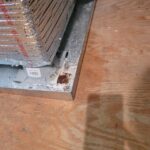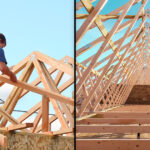Are you in the middle of a home renovation or planning to spruce up your space? One seemingly small decision can make a big difference: choosing between rounded and square drywall corners.
You might wonder why this choice matters. Well, the shape of your corners can influence the entire vibe of your home. It affects the aesthetics, durability, and even the feel of your rooms. Imagine walking through your house and feeling the seamless flow of rounded corners or the crisp, modern edges of square ones.
Which would you prefer? Dive into this article to discover the impact each option can have on your home. By the end, you’ll be armed with the knowledge to make a choice you’ll love every day. Ready to explore the possibilities? Let’s delve into the world of drywall corners.
Overview Of Drywall Corners
Drywall corners play a crucial role in interior spaces. They add shape and character to walls, influencing the overall look. Choosing the right corner style can change a room’s vibe.
Types Of Drywall Corners
Drywall corners come in two main styles: rounded and square. Rounded corners offer a softer, more modern appearance. They can make spaces feel open and flowing. Square corners are traditional and create a sharp, defined look. They suit classic designs and provide a clean finish.
Importance In Interior Design
The choice between rounded and square corners impacts design harmony. Rounded corners blend seamlessly with curved elements. Square corners accentuate straight lines and geometric patterns. Each type supports different aesthetic goals. Designers select corners based on the desired mood and style.

Credit: www.pinterest.com
Rounded Drywall Corners
Rounded drywall corners create a softer look compared to square corners, offering a modern and seamless finish. Square corners provide a more traditional and defined edge, often preferred for a classic appearance. Both styles bring unique character and style to any room.
Rounded drywall corners offer a distinctive touch to any room, seamlessly blending into modern and traditional interiors alike. Unlike their square counterparts, rounded corners create a soft transition between walls, adding a subtle elegance to your space. Whether you’re renovating or building new, these corners can dramatically change the feel of your home.Design Aesthetics
Rounded drywall corners contribute to a smoother and more sophisticated look. They soften the edges of rooms, making spaces feel more inviting and cohesive. Imagine walking into a room where the walls gently curve, creating a sense of fluidity and openness. This design choice can make smaller spaces seem larger and more connected. If you appreciate a modern aesthetic with a hint of warmth, rounded corners might be the ideal choice for you.Installation Process
Installing rounded drywall corners requires a few extra steps compared to square ones. It involves using specialized corner beads that fit the curves. These beads are installed using drywall screws or adhesive, and then covered with joint compound. The process might seem daunting at first, but with practice, it becomes a straightforward task. Many DIY enthusiasts find the challenge rewarding, resulting in a unique finish that’s worth the effort. Are you ready to take on the task?Pros And Cons
Pros: – Visual Appeal: Rounded corners add a contemporary and polished look to any room. – Safety: The absence of sharp edges makes them safer, especially in households with young children. – Durability: They are less prone to chipping compared to square corners. Cons: – Complex Installation: The process is more complex and time-consuming than installing square corners. – Higher Cost: Materials and labor can be more expensive. – Limited Compatibility: Not all design styles or furniture layouts pair well with rounded corners. Consider your home’s style and your personal preferences when choosing between rounded and square corners. The decision might seem small, but it can have a significant impact on your space’s overall look and feel. What will you choose to make your home truly yours?Square Drywall Corners
Square drywall corners offer a classic and refined look to any space. Their sharp edges provide a clean, formal appearance, often preferred in traditional and modern designs. While rounded corners have their charm, square corners stand out for their structured and neat finish.
Traditional Appeal
Square corners have a timeless elegance. They evoke a sense of order and symmetry. Many architects and designers favor them for formal interiors. This style complements historical and contemporary settings alike. Their crisp lines create a polished look in any room.
Installation Techniques
Installing square corners involves precise measurements. Use metal or paper corner beads for reinforcement. Apply joint compound evenly for a smooth finish. Ensure corners are perfectly aligned for a professional look. Sanding is crucial for achieving sharp edges.
Advantages And Disadvantages
Square corners provide a sophisticated finish. They are easy to paint and decorate. Their sharp lines can make spaces appear larger. On the downside, they are prone to chipping. Repairs might be needed more often. They also require more skill to install perfectly.

Credit: www.tiktok.com
Comparing Rounded And Square Corners
Choosing between rounded and square drywall corners impacts room aesthetics and safety. Rounded corners offer a softer look, minimizing injury risks. Square corners provide a modern, clean appearance. Each style enhances different design preferences.
When deciding between rounded and square drywall corners, you might wonder how each choice could transform your space. The difference goes beyond aesthetics; it impacts durability, maintenance, and cost. Whether you’re renovating a cozy home or designing a sleek office, understanding these aspects can help you make an informed decision.Visual Differences
Rounded corners offer a softer look. They create a seamless transition between walls, giving rooms a more organic feel. This can make a space feel more inviting and less rigid. Square corners, on the other hand, provide a clean, sharp finish. They suit modern designs where crisp lines and angles are desired. If you love a minimalist aesthetic, square corners might be your preference.Durability And Maintenance
Rounded corners tend to be more durable. They can handle bumps and knocks better since there’s no sharp edge to chip away. If you have kids or high-traffic areas, this could be a practical choice. Square corners might require more attention. Chips and wear are more noticeable on these edges. Regular maintenance might be needed to keep them looking pristine.Cost Implications
Rounded corners can sometimes be more expensive. The installation process is slightly more complex, which might increase labor costs. However, the added durability could save you money on repairs in the long run. Square corners are generally more affordable to install. They require less time and effort during the drywall process. But consider the potential cost of touch-ups if damage occurs. Which style speaks to you? Consider your lifestyle, budget, and design preferences. Each choice brings unique benefits, so weigh them carefully to decide what best suits your needs.Choosing The Right Corner Style
Choosing the right corner style for your drywall can be a pivotal decision. It impacts both aesthetics and functionality. The choice between rounded and square corners can affect your home’s overall look. Each style has its own unique benefits and considerations. Understanding these can help you make an informed decision.
Considerations For Homeowners
Homeowners should think about their personal style preferences. Rounded corners often give a softer, more modern look. They can make spaces feel more welcoming. On the other hand, square corners offer a classic and crisp finish. They suit traditional and contemporary designs alike.
Maintenance is another factor. Rounded corners may resist chipping better. This makes them ideal for families with children. Square corners might show wear more easily but can be easier to repair.
Influence Of Room Functionality
Room functionality plays a key role in corner selection. High-traffic areas benefit from rounded corners. These are less likely to sustain damage from bumps. Square corners might be preferred in low-traffic, formal spaces. They provide a structured and polished appearance.
Consider the room’s purpose. Kitchens and bathrooms often favor square corners for a clean, precise look. Living rooms and bedrooms might lean towards rounded corners for a relaxed feel.
Tips For Decision Making
Make your decision by visualizing each corner style in your space. Consider which style aligns with your overall design theme. Think about future changes you might make. A timeless corner choice can save future renovation costs.
Consult with a professional if you’re unsure. They can provide insights based on your home’s architecture. Finally, trust your instincts. Your home should reflect your personal taste and needs.

Credit: www.trim-tex.com
Trends In Drywall Corner Designs
In the ever-evolving world of interior design, drywall corner designs have taken center stage. Rounded and square corners each bring a unique flavor to your living space, offering both aesthetic and functional benefits. As trends shift, understanding these designs can help you make informed choices for your home.
Modern Applications
Rounded corners are gaining popularity in modern homes. They add a soft, seamless flow to rooms, which can make spaces feel larger and more inviting. This design is perfect if you want to achieve a contemporary look with a touch of elegance.
On the other hand, square corners are often chosen for their sleek and sharp appearance. They fit well in minimalistic designs, providing a clean and defined look. Many homeowners appreciate the tidy lines that square corners bring to modern spaces.
Influence Of Architectural Styles
The choice between rounded and square corners is not just about personal preference; it often reflects architectural styles. Traditional homes may lean towards rounded corners for their soft and classic appeal. This style can evoke a sense of warmth and nostalgia.
In contrast, industrial or urban designs frequently incorporate square corners. Their crisp edges align with the raw and edgy aesthetic typical of these styles. If you love a modern, urban feel, square corners could be the right choice.
Have you ever noticed how a simple design choice can change the entire feel of a room? Consider how these corner designs can complement your home’s architecture and your personal style. What message do you want your home to convey?
Frequently Asked Questions
What Are The Benefits Of Rounded Drywall Corners?
Rounded corners offer a soft, modern look. They are safer for kids and prevent sharp edges.
Are Square Drywall Corners Easier To Install?
Yes, square corners are easier and faster to install. They require less skill and time.
Which Drywall Corner Type Is More Durable?
Rounded corners are generally more durable. They resist chipping and wear better over time.
Do Rounded Corners Cost More Than Square Ones?
Yes, rounded corners can be more expensive. They require more materials and skill to install.
How Do Rounded Corners Affect Room Design?
They create a smooth, elegant look. Rounded corners can make small spaces feel larger and more open.
Conclusion
Choosing between rounded and square drywall corners depends on style. Rounded corners give a softer, modern look. Square corners offer a clean, classic feel. Each option has its own benefits. Consider the overall design of your space. Think about the look you want to achieve.
Rounded corners can be easier to clean. Square corners might be easier to install. Both styles can enhance your home’s appearance. Make sure to weigh the pros and cons. Decide based on your personal taste and needs.





